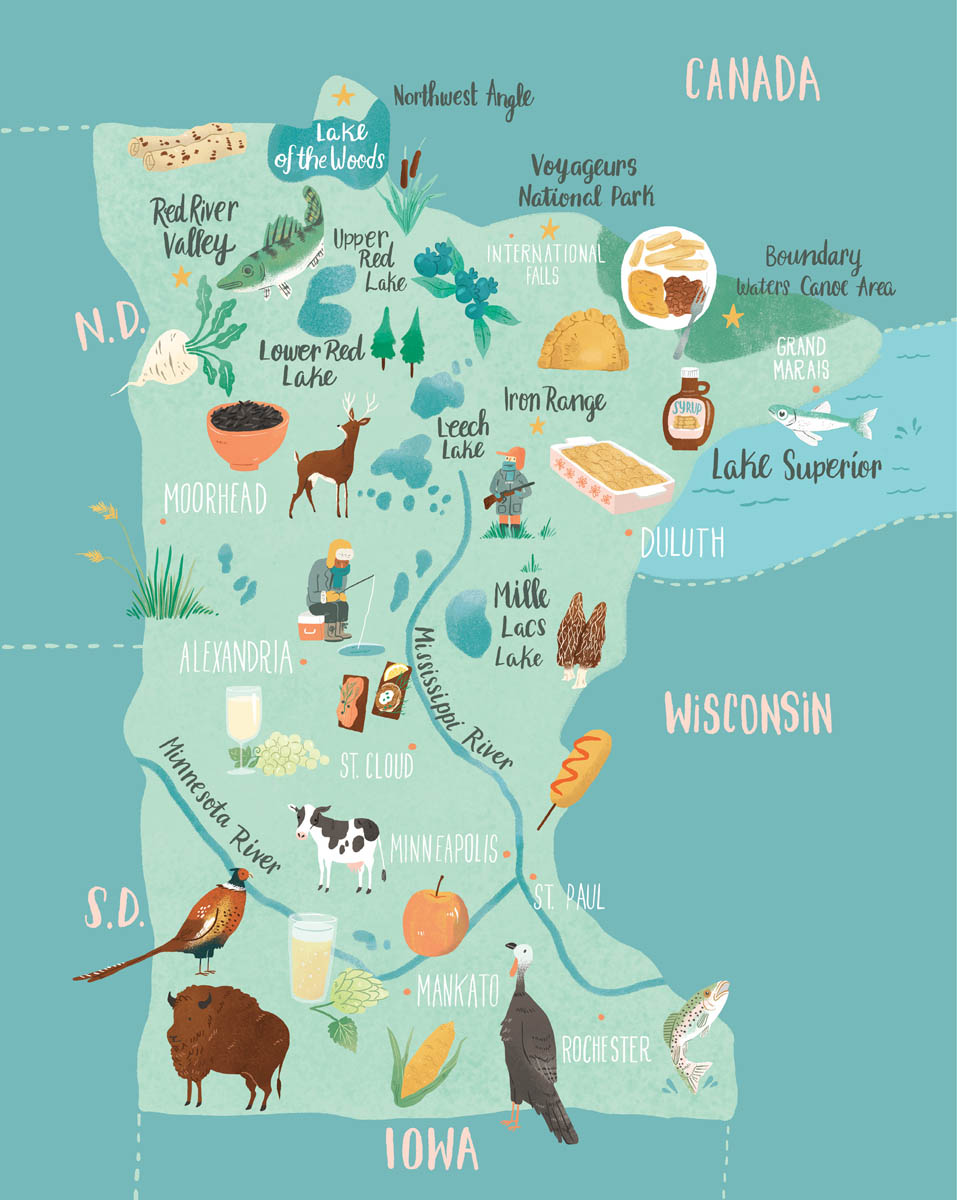



The New York Times devoted the majority of its food section on November 18, 2014, to a list of Thanksgiving dishes “that evoke each of the 50 states.” Minnesota was saddled with grape salad, a kindergarten-simple dish in which green grapes are mixed with sour cream and brown sugar, broiled, then chilled before serving. Although versions of the recipe did appear in a few old church cookbooks, almost no one had heard of the stuff, much less eaten it.
Reaction was swift and hot. Within hours, social media exploded, and the hashtag #grapegate became a sounding board for outraged Minnesotans. Across the state, newspaper and magazine columnists joined the fray both in print and online, and the story was covered on news broadcasts, including the NBC Nightly News. Grapes?! Where was the wild rice? The pie made with Honeycrisp apples, a Minnesota-born variety? Pheasant in cream? It was the same old story that has quietly annoyed Minnesotans for years: Like Rodney Dangerfield, we can’t get any respect.
In reality, Minnesota is a pretty interesting place. It has a rich and vibrant food culture, although it’s not always easy to pin down. With divergent influences from native Dakota and Ojibwe peoples, the Scandinavian and German immigrants of the 1800s, the newest residents hailing from Southeast Asia and Somalia, and current-day chefs, farmers, and artisan producers, Minnesota’s food scene is a study in opposites: traditional and contemporary, rustic and elegant, country and city. These threads are woven into whole cloth, however, by the bounty of top-notch local ingredients that appear in the best of each culture’s dishes.
Abundant lakes, rivers, and streams give Minnesota its license-plate slogan, Land of 10,000 Lakes — and yes, there really are that many. These waterways also provide some of the best regional ingredients. Lake Superior, the largest freshwater lake on Earth, harbors lake herring, trout, whitefish, smelt, and salmon. Inland waters abound with game fish, including walleye, largemouth and smallmouth bass, panfish, and trout. Wild rice is harvested from large, shallow lakes as well as from some rivers and streams. Many lakes boast seasonal populations of waterfowl, which are eagerly hunted — and cooked — by many residents each fall.
Although large expanses of Minnesota are devoted to the production of corn, soybeans, and industrial livestock, the state is home to numerous small farms, many committed to sustainable practices. Minnesota is also the sixth-largest dairy state. Much of the milk is converted into cheese and butter; producers range from huge corporations to small family farms. Minnesota-produced artisan cheese and butter, eggs from free-range hens, grass-fed beef, and top-quality produce are highly prized by discerning chefs and home cooks. Farmers’ markets, co-ops, and CSA farms are found throughout the state. Agricultural areas also provide habitat for deer, pheasants, and small game, and the fall hunting season is a major event in the state.
In 2014 (the #grapegate year), over 100 new restaurants were opened in the Twin Cities, the metropolitan area that includes Minneapolis and St. Paul and is home to about 60 percent of the state’s population. Craft brewing has also exploded; even Grand Marais, a town of 1,300 on Lake Superior just southwest of the Canadian border, boasts two microbreweries. In restaurants and home kitchens, Minnesota cooks are going back to their roots, crafting bacon, sausage, and other charcuterie, as well as cheese and artisan-style or heritage breads. Foraging, particularly for mushrooms and berries, is a popular pastime for many Minnesotans, who make up a pretty outdoorsy group in general.
We’ve got a few heavy hitters in the food world, too, both individuals and corporations. Lynne Rossetto Kasper, host of American Public Media’s radio broadcast The Splendid Table, makes her home in Minnesota. So do television food personalities Amy Thielen (host of Heartland Table) and Andrew Zimmern (host of Bizarre Foods with Andrew Zimmern). Zoë François, coauthor of Artisan Bread in Five Minutes a Day and a string of related titles (many written with fellow Minnesotan Dr. Jeff Hertzberg), has a long history in the Minneapolis food scene and lives here with her family.
Minnesota megacorporation General Mills is a food manufacturer and marketer whose current brands include Wheaties, Cheerios, Betty Crocker, Häagen-Dazs, Yoplait, Bisquick, and Nature Valley, as well as natural brands Annie’s, Cascadian Farm, and Muir Glen. Hormel Foods, based in Austin, Minnesota, is a huge brand name in itself; Hormel also encompasses the Jennie-O Turkey, Spam, Skippy peanut butter, and Di Lusso Deli brands. Other major Minnesota food corporations include International Dairy Queen, Land O’Lakes, Malt-O-Meal, Michael Foods, and Buffalo Wild Wings.
Dishing Up Minnesota celebrates Minnesota’s food and heritage, with 150 recipes ranging from traditional to modern. By the way, on November 25, 2014, as a follow-up to its earlier article on Thanksgiving foods, the New York Times ran a Web feature on “Thanksgiving Recipes Googled in Every State: Which Foods Are Unusually Popular in Each State on Thanksgiving.” Minnesota’s was wild rice casserole. You betcha; that sounds about right.
